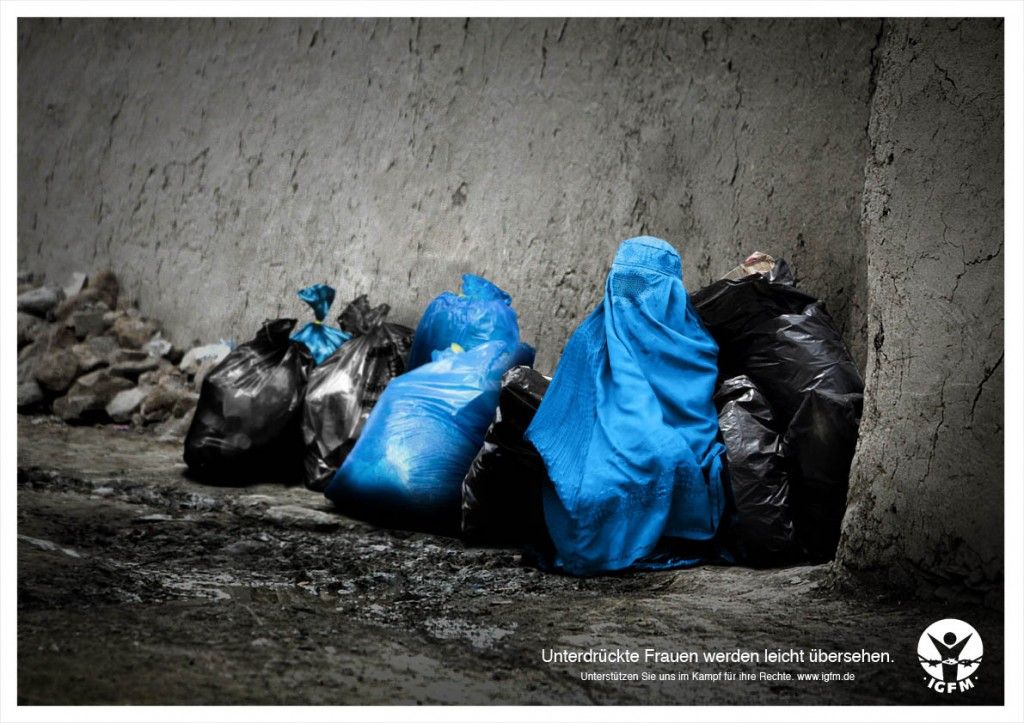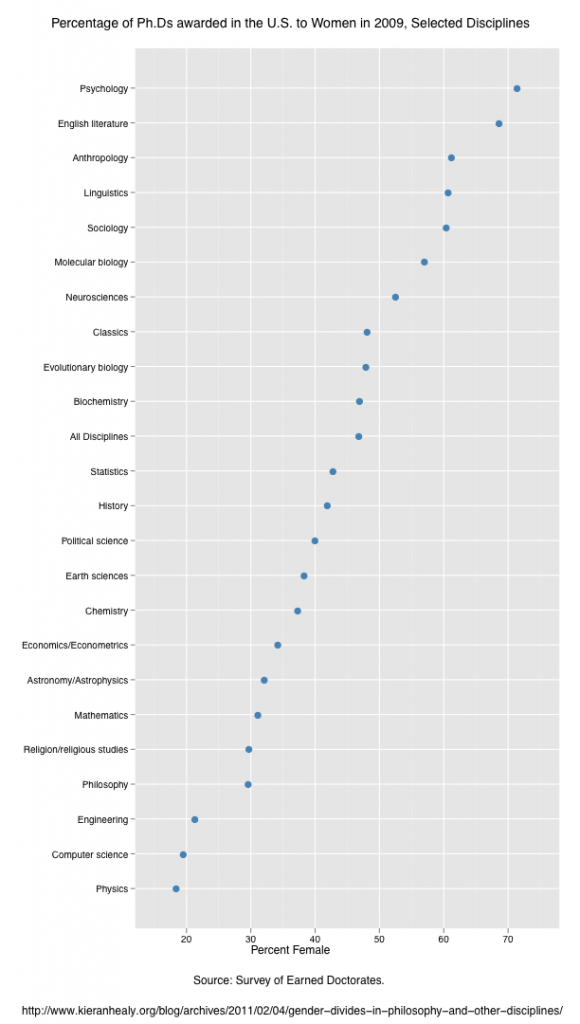In 1991 writer and cultural critic Katha Pollitt coined the phrase “The Smurfette Principle” to draw attention to the tendency for movies, TV shows, and other cultural products to include one, and just one female (source). For the unfamiliar, The Smurfs was a children’s television show, airing from 1981 to 1989, populated by a whole world of little blue men and one (sexy) blue woman:
What do Inception, the Transformers, and the Muppets all have in common? They all suffer from a trope called the Smurfette Principle. As defined by TVTropes, “The Smurfette Principle is the tendency for works of fiction to have exactly one female amongst an ensemble of male characters, in spite of the fact that roughly half of the human race is female. Unless a show is purposefully aimed at a female viewing audience, the main characters will tend to be disproportionately male.”
In 1991 Katha Pollitt, a feminist essayist wrote an article for the NY Times because she was disturbed by the lack of substantive female characters for her young daughter to watch. She found that most of the programming aimed at young people had a majority of male characters, with just one female included in the group, she called this The Smurfette Principle.
You’ve probably guessed by now that this trope was named after the only female smurf in all of Smurfville.
Once upon a time, the Smurfs were an hormonious all-dude miniature civilization comprised entirely of kind good natured little blue dudes living out their cooperative-dude existence somewhere deep in their dude forest utopia.
We’ve got Lazy, Grouchy, Jokey, Brainy, Baby, and Papa Smurf and all their Smurf buddies living out their smurfy existence free from any of those meddling, divisive, controlling, manipulative, mean women folk. But one day the evil wizard Gargamel decided on a devilish plan to sabotage smurfdom. And how will he do that? yes that’s right, by creating a female smurf!
CLIP Smurfs – The Smurfette
Gargamel: That’s it, I’ll get them through their hearts, I will send them a Smurfette
So Gargamel sent in Smurfette to cause divisions between the lovable blue creatures so he can capture and eat their tender blue flesh in a nice honey lemon sauce. Long story short, love and understanding won out when Papa Smurf worked some smurf magic and transformed Gargamel’s impostor into a real live smurf girl, “sexy” blond hair, high heels and all!
Down in the 100 acre woods, we follow the adventures of Winnie the Pooh, Rabbit, Piglet, Eeyore, Owl and Tigger – all dudes of course… in fact there’s only one female character, Kanga, who shows up occasionally as the mother of little roo.
Even Jim Hensen didn’t seem too keen on the women, along side Kermit, Gonzo, and Fozzie the Bear, Miss Piggy was the only female muppet.
We can even see the Smurfette Principle outside of programming aimed at young people. So for example you have George Lucas’ original Star Wars trilogy where Princess Leia is the only principle female character in the entire galactic empire.
If you’re like me then you are probably thinking there’s got to be something wrong, I mean, Star Trek has had a female captain, Buffy has saved the world from a demon apocalypse at least half dozen times, this trope has gotta be a thing of the past right?
Ellen Page gets Smurfette’d in Inception as her character is the only female dream team member.
Big Bang Theory has a primary main cast of brainy men plus the smurfette that lives across the hall
While there’ve been a small handful of female autobots in the Transformers universe, Arcee is the only regularly reoccurring female cast member and she only appeared in 8 episodes out of the original series. She was set to appear in the 1st Transformers live action film but she was dropped and replaced with Ironhide. She did however appear in the second film Revenge of the Fallen, which also happens to be one of the most sexist and racist films I’ve ever seen. This version of Arcee is either a hivemind with 3 different motorcycle components or the other two bikes are her sisters, it’s not exactly clear. But it doesn’t really matter anyway because they all get blown up at the end. Plus they only appear on screen for a grand total of exactly…
Clip: Transformers Revenge of the Fallen
Female Autobot: Follow us to the pillars — AHHH!
39 seconds.
Even in most seasons of Jon Stewart’s the Daily Show there has been only one female correspondent at a time.
The Smurfette principle is especially important to remember now because Hollywood is currently trying to remake everything and anything that we even vaguely remembers from the 80′s and 90′s in an attempt to cash in on our collective nostalgia, you know, instead of maybe taking a risk on things that are new and exciting.
We even have a live action Smurfs movie coming out.
We’ve had 2 big blockbuster movies based on the Transformers, and sadly there’s another one on its way.
The 2009 Star Trek reboot by JJ Abrams had Uhura as the only female character in the main bridge crew.
And just like Star Trek we can be sure that hollywood is not going to try to bring gender equality into these reboots but rather just stick with their Smurfettes.
The problem with narratives infused with the Smurfette Principle is not only the lack of women but as Katha Pollitt points out in her New York Times article, “Boys define the group, its story and its code of values. Girls exist only in relation to boys.” Basically this means that men are the default and women get to be sidekicks or sexy decorations.
Even when there’s only one female primary cast member, as videoblogger Nostalgia Chick points out in her Smurfette Principle video, they are usually just “sexy” female duplicates of their male counterparts.
Clip Nostalgia Chick – The Smurfette Principle
Nostalgia Chick – Disney was the one that kinda really started this interest in the whole default and deviation from default complex, basically this idea that men seem to want a bagina’d version of themselves.
That’s an excellent point, thank you Nostalgia Chick.
The Smurfette Principle is an alternative name for Tokenism or the Token Minority which is the inclusion of one cast member from a marginalized group in an otherwise, white, straight male ensemble. We see this most often when writers include one person of colour and that characters is usually painfully stereotyped. This is a little trick used by movie studios to pretend to appear “multicultural” and “diverse” when really they’re just upholding the status quo and not changing anything substantially.
So here’s a tip for all you Hollywood writers out there, it is in fact possible to have more than one woman in your script. Really, I swear it is. You could even have 2 or 3 women or even the majority of your cast be women.
Here’s a simple test you can ask yourself when you’re writing your scripts: “Does my movie have more than one woman on the primary cast?”
That’s it, that’s the whole test.
If you answered “NO” then you need to go back to the drawing board. If you answered “YES” then we can proceed to the Bechdel Test. Once you’ve got two female characters who are talking to each other about things other then men, then we can talk about fully developed female characters.
Song – “la, la, la, la, sing a happy song, la, la, la, la, smurf the whole day long”








